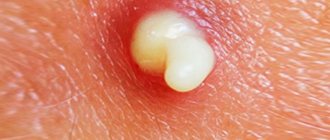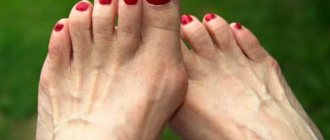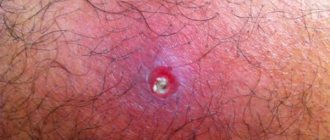A boil on the eye (furuncle) is an infectious and inflammatory disease that is characterized by the appearance of a purulent formation in the lower or upper eyelid. The main reason is the introduction of opportunistic microflora into the eye, which begins to actively multiply in it, provoking inflammation. A boil can form in people of any age. The pathology is treated by an ophthalmologist. In the case of an uncomplicated course, conservative therapy is indicated. If the disease is severe, the patient consults a doctor late, or complications develop, surgical intervention may be performed.
Etiology of the disease
At the initial stage of stye development, you can notice a raised skin defect that resembles a regular pimple. Its increase in size is accompanied by pain.
There is noticeable swelling and discoloration on the eyelid.
When the purulent stage of the boil begins to develop, the body temperature may increase.
In a normal situation, the abscess should break out on its own. If this does not happen, then surgical intervention cannot be avoided.
The main cause of the disease is Staphylococcus aureus.
Treatment
With this type of boil, independent opening is extremely undesirable. There is a great risk of introducing even more infection.
Medication
When visiting a doctor in the first stages, they most often resort to treatment with antibacterial drops if we are talking about an abscess on the eyelid. But this does not always help. In case of complications or inflammation, they resort to using various ointments . Vishnevsky ointment, erythromycin ointments. The substance must be applied directly to the abscess several times during the day until opening.
How and with what to treat? The doctor can prescribe a whole range of antibiotics in a certain sequence. When ripe, an autopsy is practiced, followed by removal of pus. Afterwards, a sterile bandage is applied. The surrounding skin is lubricated with ointment.
When there is a boil on the eyelid, the development of the abscess is stopped with antibiotics . Injections of penicillin, cefotaxime, etc. are prescribed. The boil is lubricated with ointments, and eye drops are instilled before bedtime. Broad-spectrum antibiotics are prescribed. In this case, the process can be started to such an extent that hospital treatment is required.
They use dry heating procedures, UV irradiation, and UHF. It is suggested to lubricate the skin with camphor oil, and alcohol compresses can also be prescribed.
For complications, antipyretics and painkillers are used.
Surgical
Used as a last resort, if no other methods have helped or the process is too advanced. In this case, it is treated surgically.
The patient is under general anesthesia, the doctor makes an incision and then extracts the pus. Then the area is washed and drainage is applied.
The doctor can use a special needle or, nevertheless, make an incision to allow the pus to come out. It is strongly not recommended to do this on your own.
There are recurrent appearances of an abscess on the eyelids - recurrent furunculosis . In such cases, immunotherapy is prescribed. A course of taking a staphylococcal vaccine is practiced.
Traditional methods
Mix a spoonful of soap and the same amount of honey in a water bath, adding a tablespoon of flour to the mixture during the mixing process. Make a cake from the resulting mixture and apply it overnight, securing it with a bandage.
- You can boil an egg, wrap it in a clean cloth and apply it to the infected area until it cools down.
- Pour boiling water over the crushed plantain leaves and let it brew. Then dip a piece of gauze into the liquid, and then apply it to the abscess for up to half an hour several times a day.
- People practice the use of calendula. In dried and crushed form, pour boiling water over two spoons of it, let it brew, then proceed as in the method above.
- A compress based on chamomile is applied for a quarter of an hour to relieve pain and speed up the release of pus. Then cover the boil with a bandage with ointment (for example, Vishnevsky). If the abscess has opened, carefully remove the pus and rinse with hydrogen peroxide.
- Rinse with black tea.
- Applying fresh cucumber slices.
The occurrence of barley in a child
The main reason why boils appear in a small child is poor hygiene. Children often touch their faces with dirty hands, and if there is even minor damage to the skin, infection occurs.
This disease in children is accompanied by the following symptoms:
- loss of appetite,
- deterioration in general health,
- headache,
- temperature increase.
At the slightest suspicion of the development of a boil, you should immediately consult a doctor. If the problem is not corrected in time, blood poisoning or inflammation may grow.
Causes
An infectious process that affects healthy tissue can provoke the appearance of a boil (furuncle) under the eye. As a rule, the causative agent is a staphylococcal infection. But the infection itself is not enough for the development of pathology. This requires an additional effect on the patient’s body, which provokes the development of the inflammatory process.
A boil can occur for various reasons
Among all the factors contributing to the appearance of boils on the eye, it is worth highlighting the following:
- blood poisoning as a result of cuts or microtraumas;
- exposure to low temperature;
- severe stress;
- hormonal imbalance;
- disruption of metabolic processes in the body;
- weakening of the immune system;
- development of acute infectious diseases;
- chronic diseases;
- the appearance of excess weight due to an unbalanced or unhealthy diet;
- failure to comply with personal hygiene rules.
Infection with a staphylococcal infection in combination with one or more of the factors listed above often leads to the formation of a boil on the eyelid or eyebrow.
Stages of development of stye on the eye
Boils usually do not occur suddenly. The development of the disease goes through three stages:
- The eyelid is red and swollen at first. The patient may have a sensation of a foreign body entering the eye, but visual examination does not confirm this.
- The affected area begins to itch. There is also excessive tearing of the eye and redness of the mucous membrane. Thick discharge may appear.
- After a few days, the head of the boil is visible, which differs in color. Most often it is yellow or white-yellow.
Each stage can last differently, depending on the degree of functioning of the body’s immune system and the type of pathogen.
Methods for treating a boil under the eye
In some cases, medications can help eliminate boils under the eye.
A boil under the eye is a dangerous disease, so self-medication in this case is unacceptable. It is also strictly forbidden to use traditional methods and especially heating. This can contribute to the spread of infection throughout the body and trigger the development of sepsis.
In medical practice, several therapeutic methods are used to treat boils under the eye. The main ones are:
- Medication.
- Surgical.
As additional methods, the use of traditional medicine is allowed. Herbal decoctions for oral use are usually prescribed to strengthen the immune system.
Drug treatment
When treating a boil under the eye, medications are intended for symptomatic and local treatment.
Most often, ophthalmologists prescribe:
- An ointment that contains antibiotics of different groups: Erythromycin, Tetracycline, Levomecithin.
- Antiseptic and antibacterial drops: Ciprofloxacin, Albucid, Tobramycin.
- Applications with antiseptic and anti-inflammatory drugs.
- Antibiotics for oral use: Ampiox, Cefipime, Sumamed.
When treating a boil under the eye, potent drugs are used. Therefore, they should only be prescribed by an ophthalmologist or ophthalmologist.
Also, with this treatment, rapid healing of the wound occurs after the boil breaks through, which prevents the formation of scars and tissue on the skin.
Surgery
There is a rule in surgery: “Where there is pus, there is an incision.” Therefore, the main method of treating a boil is opening the lesion and sanitizing it.
This technique is used when conservative therapy is ineffective. The operation is performed in a hospital by a doctor under local anesthesia. To do this, the boil is injected with anesthetics. Then the boil is opened, the pus is removed from it, and the cavity is washed with an antiseptic solution. For quick healing, a special medicine is infused into the wound.
When treating a boil under the eye with medications prescribed by a doctor, the prognosis for recovery is always positive. Qualified medical care for this pathology helps to quickly stop inflammatory processes, clean the boil cavity from pus and remove the necrotic core. This prevents the infection from spreading throughout the body and eliminates relapse.
The main symptoms and manifestations of boils on the eye
The first manifestations of the disease include inflammation, swelling and redness of the eyelid. To the touch, its affected surface is compacted. After a couple of days, you may notice an abscess in the form of a large pimple. A person is often bothered by the following symptoms:
- pain and itching,
- excessive tearing,
- feeling of a speck in the eye,
- swelling that completely covers the eye.
If the immune system is severely weakened, infection can cause:
- temperature rise,
- lack of appetite and nausea,
- general malaise,
- headaches,
- enlarged cervical lymph nodes.
What should you not do if you have a boil?
To speed up the healing process during treatment, it is recommended to follow a number of restrictions. It is necessary to completely avoid contact between eyes and hands, and, if possible, do not use contact lenses or cosmetics.
To prevent the accumulation of pathogenic microorganisms around the eye, there is no need to cover the formation with a band-aid. Since the disease is infectious, it is necessary to use individual dishes and towels so as not to infect someone else.
After the purulent contents are released, you should carefully remove it with a cotton swab and treat the wound with an antiseptic. There is no need to apply a bandage or bactericidal patch.
It is strictly forbidden to squeeze out the boil or warm it up, as there is a risk of blood poisoning or the development of acute thrombophlebitis (inflammation of the vein and blood clot formation)
Diagnostic methods used
When the first signs of a boil appear on the eye, you should definitely consult an ophthalmologist. An external or internal abscess can be detected by visual examination of the eye with eversion of the eyelid. In most cases, there is no need to conduct additional ophthalmological diagnostics.
If barley occurs frequently, you cannot do without consulting other doctors, namely a dermatologist, endocrinologist and gastroenterologist. Blood, urine and stool tests are also required to detect parasites.
Mandatory analyzes are considered:
- bacteriological examination of a smear from the affected area of the eye,
- blood culture test for sterility.
Differential diagnosis of a boil is carried out if there are other accompanying pathologies.
How to recognize the symptoms?
When such a formation appears, a person may develop a fever. Everyone should know what a boil under the eye looks like, since the pathology can manifest itself in any person. When violated, an abscess is formed containing liquid inside. As the formation matures, an abscess is observed, which turns red, becomes inflamed and soon opens itself. Purulent fluid comes out of the tumor. A boil can form on the eyelid from the inside and outside, and the area closer to the eyebrows is also often damaged. It is also possible to have multiple pustules at the same time. A boil on the lower eyelid causes the patient not only aesthetic discomfort, but also causes other symptoms:
- foreign body sensation;
- itchy sensations;
- redness of the eye;
- swelling in the area where the abscesses have formed;
- weakness and malaise throughout the body associated with intoxication;
- high body temperature;
- nausea;
- headaches.
Preventive methods
To prevent boils on the eye from bothering you and becoming chronic, you need to adhere to preventive measures:
- wash your hands more often,
- do not touch your eyes with dirty hands,
- cosmetics must be hypoallergenic,
- buy eye cosmetics of proven quality,
- lead an active lifestyle aimed at increasing immunity,
- correctly remove a foreign body from the eyes.
If you notice the first symptoms of a boil, you should immediately consult a doctor. Timely treatment eliminates the development of complications and negative consequences.
Possible complications
Boils go away on their own before our eyes. But with reduced immune defense and the presence of endocrinological diseases, the condition may worsen and complications may develop.
What to watch out for:
- abscess formation - infection of adjacent tissues occurs;
- chalazion - purulent masses do not come out, but become compacted to form a nodule;
- chronicity of the process - with frequent relapses, decreased immunity;
- phlegmon of the orbit - infection of the eyeball, orbit. Possible loss of vision;
- sepsis, meningitis - due to the spread of infection through the bloodstream.
A boil can pop up in anyone.
It is important to identify the causes of the disease and cure it completely. Otherwise, complications may occur, including loss of vision. The article has been verified by the editors
Danger of boils
Pustules are a deep purulent-necrotic inflammation and their localization on the head is associated with great risk. Therefore, before you cure a boil yourself, you need to remember the consequences. Complications of a nasal boil include meningitis, inflammation of the veins on the face and, most dangerously, blood poisoning, which can lead to death. That is why you should never try to squeeze out pus on the nose, and open the boil on the vestibule of the nose and other areas of the face yourself. The infection during these actions very quickly penetrates the blood and can spread to the brain. This is due to the structural features of the facial veins - they do not have the ability to limit the movement of infected blood clots (thrombi).
The following pathologies may also result:
- acute purulent inflammation of the orbit;
- thrombosis (blockage) of the ophthalmic veins;
- sudden appearance of erysipelas of the face;
- Boils can merge into a carbuncle with damage to the deep layers of the dermis.
Severe consequences are observed by doctors in 4% of patients.
Prevention measures
To avoid the appearance of a boil near the nose, prevention of this disease is necessary, especially if the person has already suffered from furunculosis. First of all, it is necessary to avoid scratching and microdamage to the skin, because pathogenic microorganisms often enter the body through this route. If even a minor scratch appears, it is better to immediately treat it with iodine and hydrogen peroxide. You also need to maintain hygiene. Two or three times a week, the house needs to be thoroughly cleaned.
In case of skin diseases, it is necessary to regularly consult a doctor. In addition, doctors say that you need to follow proper nutrition and lifestyle. You need to exclude flour products, semi-finished products, sausages, sweets and smoked foods from your diet. If you have caries, tonsillitis or sinusitis, then it is necessary to cure these diseases.











